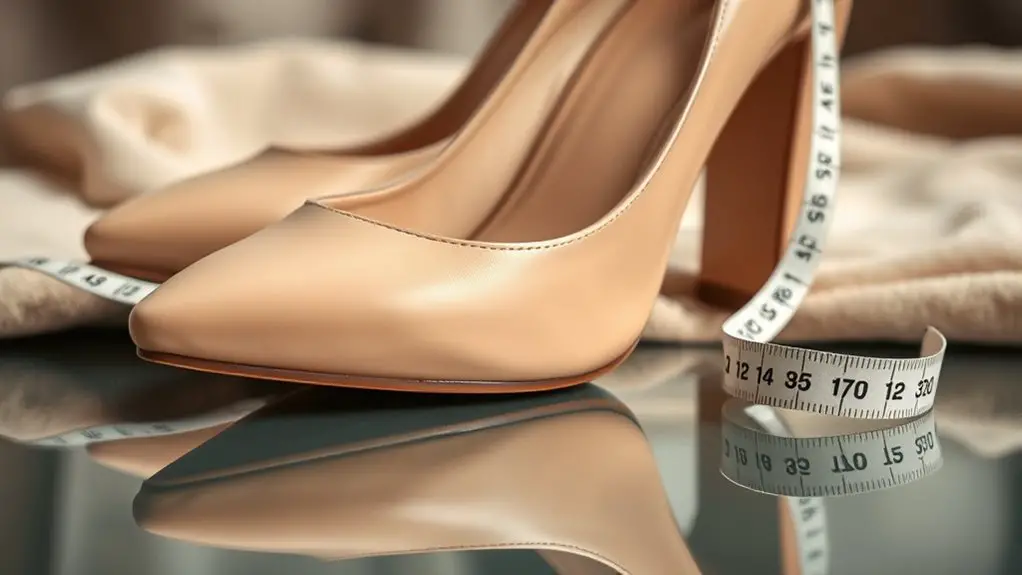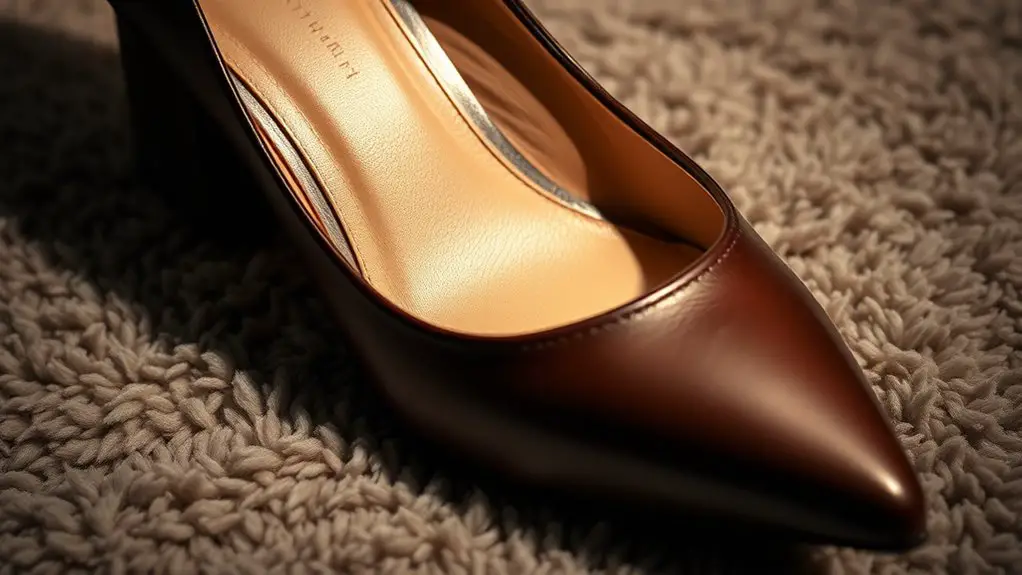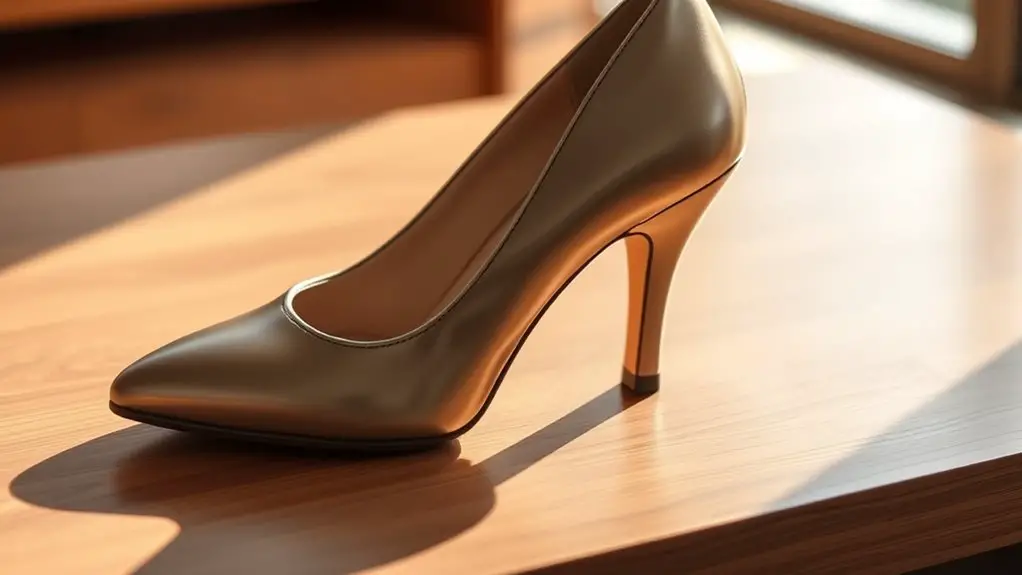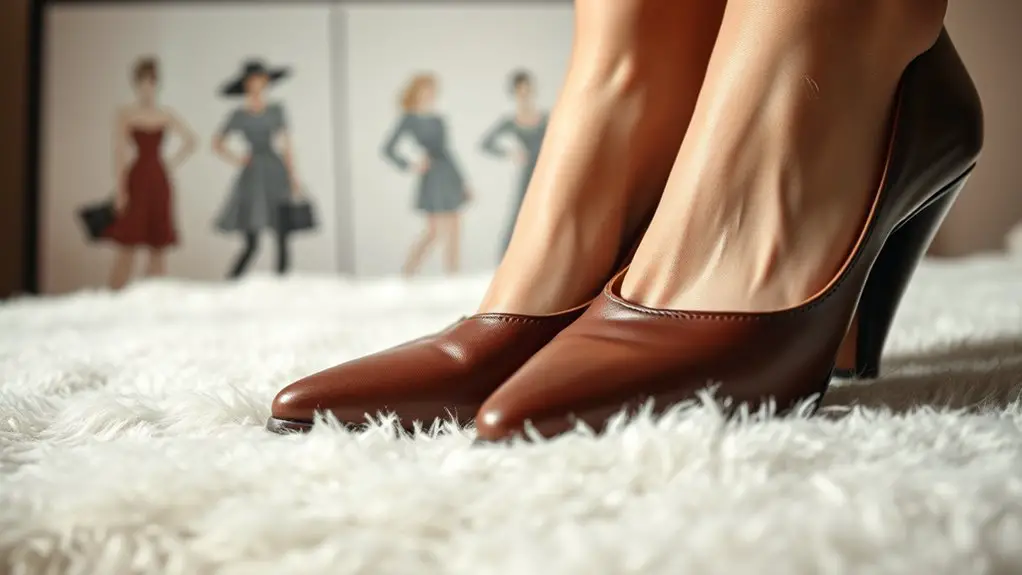When it comes to comfortable heels, you need to contemplate a few key factors. First, make sure you find the perfect fit; a snug heel counter and ample toe room are essential. Next, the ideal heel height is between 2-3 inches. Look for quality materials like leather and cushioned insoles for extra support and shock absorption. Don’t forget stability features like ankle straps, and remember that the shape of the shoe can influence comfort. There’s much more to discover!
The Importance of a Proper Fit

Finding the perfect fit is vital when it comes to comfortable heels. You might think you know your size, but foot measurement techniques can reveal surprising nuances. Using a Brannock device or tracing your foot can help guarantee you’re not just fitting into a number but finding your true size. Remember, shoe sizing standards can vary greatly between brands and styles, so don’t be afraid to try multiple options.
When you slip on a pair, pay attention to the fit across the width and the arch. A snug heel counter and enough room for your toes are essential. Don’t forget to walk around—comfort should extend beyond just standing. With the right fit, you’ll not only look stylish but also feel confident, allowing you to strut your stuff without the worry of discomfort. Prioritizing fit is your first step toward heel happiness!
Heel Height: Finding Your Sweet Spot
When it comes to heel height, finding your sweet spot is essential for both style and comfort. You’ll want to contemplate not just the ideal height for your look, but also how it complements your foot shape and provides necessary arch support. Striking the right balance can make all the difference in how you feel throughout the day.
Optimal Heel Height
Although it might seem that higher heels are always more glamorous, the ideal heel height truly balances style and comfort. You’ll want to aim for a heel height that enhances your silhouette without compromising your well-being. Generally, a heel height between 2 to 3 inches is a sweet spot for many.
| Heel Height (inches) | Comfort Level |
|---|---|
| 1-2 | High Comfort |
| 2-3 | Balanced Comfort |
| 3-4 | Moderate Comfort |
| 4-5 | Low Comfort |
| 5+ | Uncomfortable |
Understanding this comfort balance will help you choose heels that let you shine without the pain. Remember, it’s all about looking fabulous while feeling great!
Arch Support Importance
Arch support is a game-changer for your footwear experience, especially when choosing heels. It’s essential to know your arch type—high, medium, or flat—because each requires different support levels to keep you comfortable and stylish. Heels with tailored arch support can alleviate pressure and prevent fatigue, allowing you to walk with confidence and ease. Look for brands that prioritize ergonomic designs, featuring contoured footbeds that cradle your arches perfectly. This not only enhances comfort but also promotes better posture and aligns your body. As you select your next pair, remember that the right arch support can transform your heel experience, making those chic styles more wearable for longer periods. Your feet will thank you!
Foot Shape Considerations
Finding the right heel height isn’t just about style; it’s about understanding your unique foot shape. Your foot anatomy plays an essential role in determining which heel heights will be comfortable for you. If you have a high arch, opting for a lower heel can provide better support, while those with a flatter foot might thrive in a mid-height heel. When exploring various shoe styles, consider how the heel height complements your foot’s natural contours. A sweet spot might be around 2 to 3 inches for many, balancing elegance with comfort. Remember, it’s not just about looking good; it’s about finding the heel height that feels right, allowing you to strut with confidence and ease.
Arch Support and Cushioning
When you’re stepping out in heels, the last thing you want is discomfort creeping in after just a few hours. That’s why paying attention to arch support types and cushioning materials is essential. Look for heels with built-in arch support, whether it’s a contoured footbed or a more structured midsole. This can help distribute weight evenly and reduce strain on your feet.
Cushioning materials are equally important; memory foam and gel inserts can provide that plush feel you crave. These materials not only enhance comfort but also absorb shock, making each step feel lighter.
Don’t shy away from experimenting with different styles—platforms and block heels often offer better support due to their design. By choosing wisely, you can enjoy stylish heels without sacrificing comfort. After all, it’s possible to strut your stuff while feeling fabulous and pain-free!
The Role of Materials in Comfort

Choosing the right materials can make all the difference in heel comfort, with three key types standing out. These materials not only influence the feel of the heel but also provide necessary support and style.
| Material Type | Key Features | Comfort Benefits |
|---|---|---|
| Leather | Durable, flexible | Molds to your foot shape |
| Mesh | Lightweight, breathable | Enhances airflow |
| Memory Foam | Cushioned, adaptive | Distributes weight evenly |
When you’re shopping for heels, look for material flexibility. This allows the shoe to move with your foot, preventing stiffness. Also, opt for breathable fabrics that keep your feet cool and dry, especially during long wear. It’s these thoughtful material choices that can transform your heels from a painful necessity into a stylish delight, ensuring you can strut confidently wherever you go.
Toe Box Design: Freedom for Your Feet
A well-designed toe box is just as important as the materials used in your heels. It directly affects your comfort and overall foot health. When choosing heels, pay attention to these vital elements:
- Toe Box Shape: Look for a shape that mimics your foot’s natural contour. A rounded or almond shape allows for movement without pinching.
- Toe Box Materials: Opt for breathable materials like leather or soft textiles. These not only provide flexibility but also prevent excessive sweating and discomfort.
- Space for Your Toes: Confirm there’s enough room for your toes to wiggle. A cramped toe box can cause pain and long-term issues.
Stability and Balance Features

While you might be drawn to the aesthetic allure of a pair of heels, stability and balance features are crucial for ensuring you can wear them with confidence and ease. Look for shoes equipped with advanced stability mechanisms like wider heel bases or strategically placed arch support. These features help distribute your weight evenly, reducing pressure on your feet and improving your posture.
Balance enhancement is another critical aspect; consider heels with shock-absorbing materials or cushioned footbeds that provide a secure grip. Some brands even incorporate innovative designs, such as ankle straps or contoured soles, that work together to enhance stability during movement.
When selecting your heels, pay attention to these details. They not only elevate your style but also empower you to walk gracefully, turning heads without sacrificing comfort. Prioritizing stability and balance will transform your heel-wearing experience into one that feels as good as it looks.
The Impact of Shoe Shape
Shoe shape plays a pivotal role in both comfort and aesthetics, often dictating how a pair of heels feels on your feet. When selecting heels, consider these three key factors:
Shoe shape significantly influences comfort and style, making it essential to choose the right heels for your feet.
- Heel Curvature: A gentle curve aligns your foot better, reducing pressure on the balls of your feet.
- Shoe Width: A wider shoe accommodates your foot’s natural shape, preventing pinching and discomfort throughout the day.
- Toe Box Shape: Opt for a rounded or almond-shaped toe box to allow your toes to move freely, enhancing overall comfort.
Choosing heels with the right shape not only boosts comfort but also elevates your style. Trends are shifting toward more ergonomic designs that prioritize well-being without sacrificing flair. So, whether you’re strutting into a meeting or heading out for a night, understanding the impact of shoe shape can keep you looking chic and feeling fantastic.
Break-In Period: What to Expect
Finding the perfect pair of heels isn’t just about shape; it’s also about how they fit your feet over time. During the break-in period, you can expect some adjustments as the materials soften and conform to your unique foot structure. Don’t worry if they feel a bit snug at first; that’s completely normal.
To ease the process, consider these break-in tips: wear your heels around the house for short periods, gradually increasing the duration. Pair them with thicker socks to stretch the material gently. Keep in mind, comfort expectations vary based on heel height and style, so listen to your feet. If discomfort persists, it might be a sign to reassess your choice. Remember, a little patience goes a long way in transforming those stylish heels into your new favorites, making every step feel like a walk in the park.
Tips for Maintaining Comfort Throughout the Day
To keep your heels feeling fabulous all day, it’s crucial to start with the right fit—those snug spots can lead to discomfort faster than you think. Consider adding cushioned insoles; they can transform any pair into a dream. With these game-changing tips, you’ll strut through the day with style and ease.
Choose the Right Fit
When it comes to choosing the right fit for heels, a perfect match can make all the difference in your comfort level throughout the day. The key is accurate shoe sizing based on your unique foot measurement. Here are three tips to guarantee you find the ideal fit:
- Measure Your Feet: Always measure your feet at the end of the day when they’re slightly swollen to get an accurate size.
- Try Before You Buy: Walk around in the heels and pay attention to how they feel; comfort is paramount.
- Consider Width: Don’t overlook width options—your foot shape can greatly impact overall comfort.
Use Cushioned Insoles
While you might love the look of your heels, comfort often takes a backseat without the right support. Investing in cushioned insoles can revolutionize your experience, giving your feet the pampering they deserve. Look for insoles made from high-quality cushioned materials that provide ample shock absorption, reducing impact with every step. The insole thickness is essential; too thin, and you’ll feel every hard surface, too thick, and your heels might not fit properly. Aim for a balance that allows for flexibility while maintaining your shoe’s structure. Many trendy brands now offer stylish options with built-in cushioning, so you don’t have to sacrifice aesthetics for comfort. Elevate your heel game with the right insoles and enjoy all-day wear without the pain.
Frequently Asked Questions
How Can I Measure My Foot for the Perfect Fit?
To measure your foot for the perfect fit, trace your foot’s outline, noting foot length and arch height. Use a ruler for accuracy, ensuring you account for both measurements to find your ideal size.
Are Expensive Heels Always More Comfortable?
Expensive heels aren’t always more comfortable. While price comparison often suggests better material quality, fit and design play essential roles. Comfort can vary, so try different pairs to find the perfect balance between style and wearability.
Can I Customize My Heels for Better Comfort?
Absolutely, you can customize your heels for better comfort! Consider adding heel inserts or custom padding. These adjustments can greatly enhance your shoe’s fit and support, making stylish heels feel more wearable throughout the day.
What Are the Best Brands for Comfortable Heels?
Imagine walking on clouds—brands like Clarks and Naturalizer offer comfort technology that feels just like that. With varying heel heights, these stylish options guarantee your feet stay happy all day, making every step feel effortless.
How Often Should I Replace My Heels for Optimal Comfort?
You should replace your heels every 6-12 months, depending on their heel lifespan. Look for comfort indicators like cushioning wear, sole flexibility, and stability. Regular updates keep your style fresh and feet happy!



